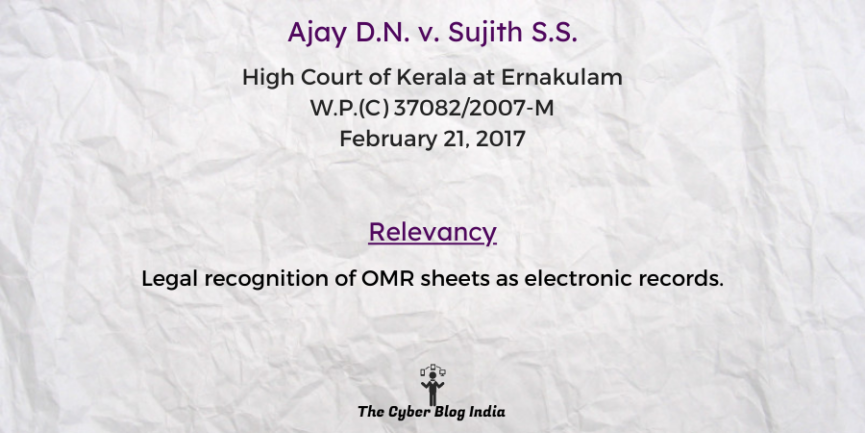Ajay D.N. v. Sujith S.S.

Ajay D.N. v. Sujith S.S.
In the High Court of Kerala
W.P.(C) 37082/2007-M
Before Justice P.V. Asha
Decided on February 21, 2017
Relevancy of the case: Legal recognition of OMR sheets as electronic records.
Statutes & Provisions Involved
- The Information Technology Act, 2000 (Section 2, 4)
- The Indian Evidence Act, 1872 (Section 45A, 65A, 65B)
Relevant Facts of the Case
- The University of Kerala invited applications for selection and appointment to the post of Assistant Grade II. Initially, the written test accounted for 100 marks with 5 marks allotted towards handwriting.
- The tenure of the nominated body, which was exercising the Syndicate powers and decided to conduct the selection, expired. The newly-elected body of the Syndicate constituted a selection board. Consequently, in a meeting, the selection board decided to scale down the marks to a total of 100. 75 marks for the written test and 25 marks for the interview.
- The number of vacancies was 378. The selection board decided to shortlist candidates equal to 5 times the number of vacancies for the interview. Subsequently, they conducted the interview and published the final rank list on 08.04.2008, containing 1401 candidates based on merit.
- Consequently, the Syndicate resolved to appoint 200 candidates. The body issued appointment orders and 170 candidates joined duty between 22.05.2008 and 3.7.2008.
- Thereupon, certain candidates filed writ petitions questioning the selection and its process. Some of the petitioners included the Vice-Chancellor, the Pro-Vice-Chancellor, and members of the Syndicate separately.
Prominent Arguments by the Advocates
- The petitioner’s counsel argued that the Upa Lok Ayukta’s findings that OMR sheets were destroyed to conceal the manipulation of the marks in the written examination were baseless. Furthermore, there was no manipulation of electronically recorded scores.
- The counsel subsequently contended that the experts before the Sukumaran Committee, as well as the Upa Lok Ayukta, ruled out tampering with either the CD or the hardware after verifying the OMR system’s hardware and the CDs. The hard disk of OMR recorded marks is an electronic record.
- Furthermore, they submitted that the OMR system used in the examination falls within the definition of ‘computer’ under Section 2(i) of the Information Technology Act, 2000.
- In addition, the counsel submitted that OMR sheet is legally recognized under Section 4 of the Information Technology Act, 2000, as an electronic record.
Opinion of the Bench
- The Court observed that the OMR sheet comes under a “secure system” as defined under Section 2(ze) of the Information Technology Act, 2000. Furthermore, the OMR system must also adapt to cyber secure practices, under Section 2(nb) of the Act, when making electronic copies available to the public.
- Hence, because of the above, the Hon’ble court agreed that the electronic record of the OMR sheet had legal recognition defined under Section 4 of the Information Technology Act, 2000.
- Nonetheless, the system was untampered with per the experts’ opinion under sections 45A, 65A, and 65B of the Indian Evidence Act. The instructions given to the candidates in the OMR answer sheets are part of a secure system, which conforms with cyber security standards.
Final Decision
- The bench upheld the selection of appointed candidates, and the benefits conferred to the candidates upon their appointment.
- Furthermore, the bench mandated the necessity of taking appropriate action against the University for their casual, careless and irresponsible approach to conduct the examinations.
